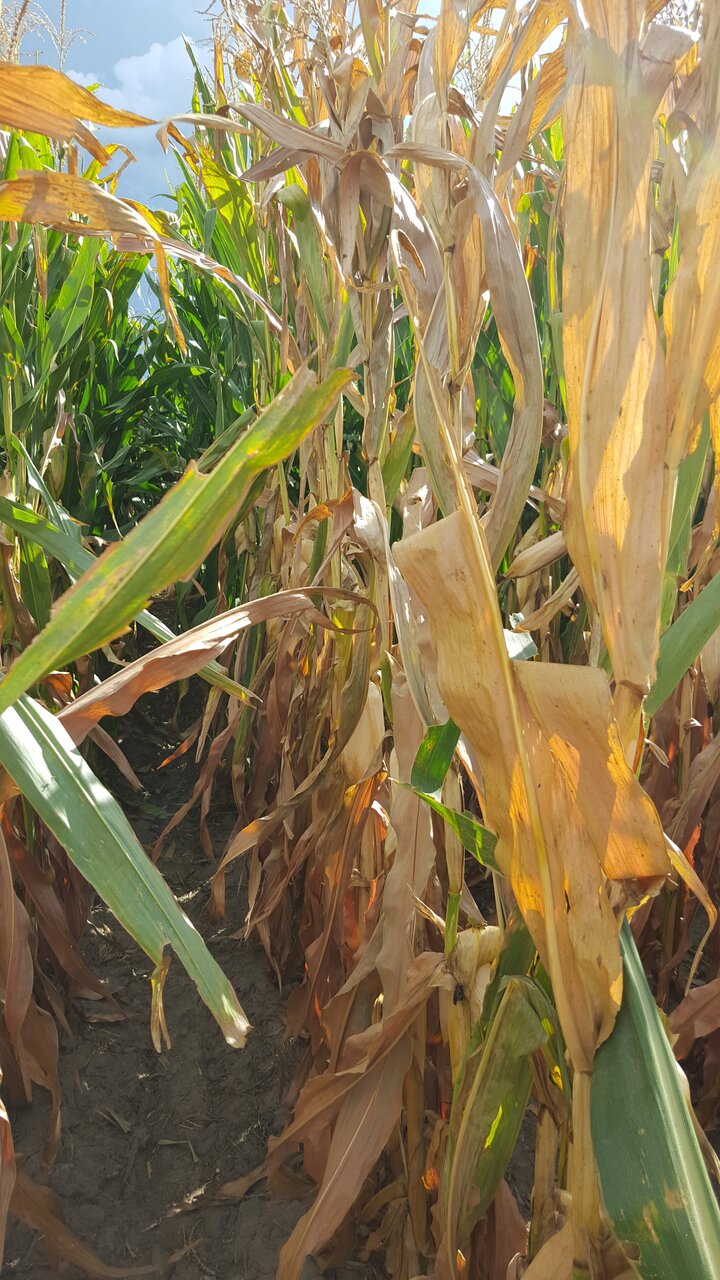

Sept. 11, 2015
Crown and stalk rot diseases continue to become evident in some corn fields in Nebraska. Producers should watch for early symptoms and consider monitoring high risk fields for stalk and ear rot diseases in their corn as harvest approaches.
Stalk and crown rot diseases can cause initial symptoms that are easily misdiagnosed. The earliest visible symptoms are the discoloration or rapid death of the upper leaves or whole plant (Figures 1a and 1b). Affected plants may occur in patches where stress occurred or seemingly randomly scattered. Premature plant or leaf death is due to the stoppage of water translocation up the plant. Unfortunately, submitting just brown, dead/dying leaves to the UNL Plant and Pest Diagnostic Clinic or other diagnostic labs in an effort to identify the cause will not provide enough evidence of stalk or crown rot disease. Instead, be sure to split stalks, especially below the soil line into the root zone to check for crown rot or discoloration (Figure 2). When submitting a sample(s) for diagnosis, collect whole plants, including the root ball and wrap in plastic, to get the most accurate diagnosis.Weakened stalks have become evident in some corn fields. Remember that high winds can lead to lodged corn where stalks have become weakened by stalk rot diseases and other problems. Crop stress during the 2015 growing season has and will likely contribute to the development of some stalk rot diseases. Pay special attention to fields that have one or more risk factors for stalk rot diseases and lodging:
- Higher yielding hybrids
- Lost leaf area (due to leaf diseases, hail, etc.)
- Excessive rainfall/ponding anytime during season
- Stalk wounding, usually by hail
- High planting populations
- Thin stalks

Charcoal rot is one of the few diseases that is more common during drought conditions, and so, is more likely to affect corn in non-irrigated fields or pivot corners. The disease is characterized by the presence of many minute black round structures inside the stalk that can give it a gray to black appearance (hence the name). In addition, the fungus that causes charcoal rot, Macrophomina phaseolina, has a wide host range and can cause the same disease in several crops, including corn, soybean, sorghum, alfalfa, and others.
Fusarium stalk rot is especially common during damp conditions, but may occur anywhere, including in irrigated fields this year. The pathogen, Fusarium verticillioides, can sometimes be visible as white fungal growth on the outside of stalks at the nodes. Eventually, the disease may cause a pink to salmon discoloration of the inside of stalks.
Anthracnose stalk rot is caused by the fungus Colletotrichum graminicola, which also causes a leaf disease and is a common cause of top rot disease of corn. In more advanced stages the disease can cause the development of black lesions visible on the outside of the stalk.
Diplodia stalk rot can cause both an ear and a stalk rot. The fungus causing Diplodia stalk rot reproduces with microscopic spores inside minute raised black structures (pycnidia) that can give the stalk a rough/sandpaper-like feeling (Figure 3).
Physoderma brown spot most commonly causes a leaf disease, but under some conditions can cause stalk rot disease. The pathogen causing Physoderma needs a lot of moisture and is more common this year following the frequent rainfall events earlier this year.
More details and photos of these and other diseases can be found in Corn Disease Profile II: Stalk Rot Diseases and in greater depth in Common Stalk Rot Diseases of Corn.Management
Nothing can be done at this point in the season to stop stalk or ear rots as affected plants will continue to degrade over time further weakening them. But, you can work to minimize your losses by identifying which fields have the worst stalk rot diseases and adjust the harvest order of those fields. Consider harvesting or chopping those fields that are heavily impacted by stalk rots first or earlier to minimize losses that can occur after lodging.
If you are in doubt about the identity of a disease or cause of another plant problem, you can submit a sample to the UNL Plant and Pest Diagnostic Clinic (P&PDC) for diagnosis. For more information about these and other plant diseases or for submission forms and submission instructions for the P&PDC, visit the Clinic's Crop Watch website.
Tamra Jackson-Ziems
Extension Plant Pathologist
